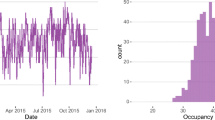Abstract
The growing influx of patients in healthcare providers is the result of an aging population and emerging self-consciousness about health. In order to guarantee the welfare of all the healthcare stakeholders, it is mandatory to implement methodologies that optimize the healthcare providers' efficiency while increasing patient throughput and reducing patient's total waiting time. This paper presents a case study of a conventional radiology workflow analysis in a Portuguese healthcare provider. Modeling tools were applied to define the existing workflow. Re-engineered workflows were analyzed using the developed simulation tool. The integration of modeling and simulation tools allowed the identification of system bottlenecks. The new workflow of an imaging department entails a reduction of 41 % of the total completion time.








Similar content being viewed by others
References
Granja C, Cruz P, Mendes A. Healthcare Decision Support System. In 10th International Chemical and Biological Engineering Conference p. 1099–1104, 2008
Direcção de Serviços de Epidemiologia e Estatísticas de Saúde - Divisão de Estatísticas da Saúde. Centros de Saúde e Hospitais - Recursos e Produção do SNS 2007. Lisboa:; Report No.: 1645–8893, 2008
Diwas SKC, Terwiesch C: The effects of focus on performance: Evidence from California Hospitals. Manage Sci 57(11):1897–1912, 2011
Lee CW, Kwak NK: Strategic Enterprise Resource Planning in a Health-Care System Using a Multicriteria Decision-Making Model. J Med Syst 35(2):265–275, 2011
Vissers JMH, Adan IJBF, Dellaert NP: Developing a platform for comparison of hospital admission systems: An illustration. Eur J Oper Res 180(3):1290–1301, 2007
Arenas M, Bilbao A, Caballero R, Gomez T, Rodriguez MV, Ruiz F: Analysis via goal programming of the minimum achievable stay in surgical waiting lists. J Oper Res Soc 53(4):387–396, 2002
Vanberkel PT, Boucherie RJ, Hans EW, Hurink JL, van Lent WAM, van Harten WH: An exact approach for re-lating recovering surgical patient workload to the master surgical schedule. J Oper Res Soc 62(10):1851–1860, 2011
Patrick J, Puterman ML: Improving resource utilization for diagnostic services through flexible inpatient sched-uling: A method for improving resource utilization. J Oper Res Soc 58(2):235–245, 2007
Kolesar P: A markovian model for hospital admission scheduling. Manag Sci 16(6):384–396, 1970
Adan I, Vissers JMH: Patient mix optimisation in hospital admission planning: a case study. Int J Oper Prod Man 22(4):445–461, 2002
Ceschia S, Schaerf A: Local search and lower bounds for the patient admission problem. Comput Oper Res. 38:1452–1463, 2011
Ahmed M, Alkhamis T: Simulation optimisation for an emergency department healthcare. Eur J Oper Res 198(3):936–942, 2008
Persson M, Persson J: Health economic modeling to support surgery management at a Swedish hospital. Omega 37(4):853–863, 2009
Topaloglu S: A multi-objective programming model for scheduling emergency medicine residents. Comput Ind Eng 51(3):375–388, 2006
Su S, Shih CL: Managing a mixed-registration-type appointment system in outpatient clinics. Int J Med Inform 70(1):31–40, 2003
Li MF, Tsai JCH, Chen WJ, Lin HS, Pan HB, Yang TL. Redefining the sonography workflow through the application of a departmental computerized workflow management system. Int J Med Inform 2012
European Association of Radiology. [Online]. Available from: http://www.ear-online.org
American College of Radiology. [Online]. Available from: http://www.acr.org
Reiner BI, Siegel EL: The cutting edge: strategies to enhance radiologist workflow in a filmless/paperless imaging department. J Digitl Imaging 15(3):178–1900, 2002
Siegel EL, Reiner B: Work Flow Redesign: The Key to Success When Using PACS. J Digitl Imaging 16(1):164–168, 2003
Ralston MD, Coleman RM, Beaulieu DM, Scrutchfield K, Perkins T: Progress toward paperless radiology in the digital environment: Planning, implementation, and benefits. J Digitl Imaging 17(2):134–143, 2004
Reiner B, Siegel E, Carrino JA: Workflow optimization: current trends and future directions. J Digitl Imaging 15(3):141–152, 2002
Author information
Authors and Affiliations
Corresponding author
Rights and permissions
About this article
Cite this article
Granja, C., Almada-Lobo, B., Janela, F. et al. An Optimization based on Simulation Approach to the Patient Admission Scheduling Problem: Diagnostic Imaging Department Case Study. J Digit Imaging 27, 33–40 (2014). https://doi.org/10.1007/s10278-013-9626-3
Published:
Issue Date:
DOI: https://doi.org/10.1007/s10278-013-9626-3




